Sweet pepper pests and their control: photos of leaves and the most effective methods for saving the crop
Every gardener dreams of growing a rich and tasty harvest of bell pepper on his plot. But even if all agrotechnical rules are followed, the vegetable can become sick or become the target of attack by insect pests. The reasons can be completely different. For example, unfavorable climatic conditions, frequent rains and fogs. Let's tell you more about pests of sweet peppers and how to combat them.
Pests of sweet bell peppers
Insects may appear in the beds during flowering or fruiting. Some of them live underground, causing damage to the root system. Others live on leaves and stems, sucking all the juices from the plant.
Aphid
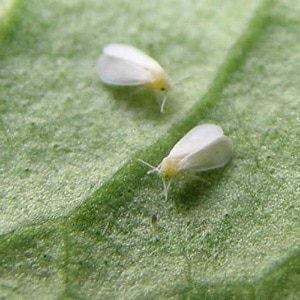
Small midges most often appear due to non-compliance with crop rotation rules. For example, the soil and garden tools were not disinfected before planting.
Sometimes aphids are difficult to notice with the naked eye, so you should periodically inspect the leaves of the seedlings from the back.
You can understand that aphids have settled on the ridges by the following signs:
- a shine and sticky film appears on the leaves;
- insect larvae are visible;
- The leaves dry out and begin to curl.
Thrips
Black insects with a striped abdomen. Thrips mainly harm young plants in the formative stage. Pests feed on nectar and juice from fruit ovaries.
The first signs of infection are light spots on the leaves.Over time, the spots merge with each other, and the leaf becomes completely white. The stems become bent and the fruits take on an ugly shape.
Tobacco thrips is especially common. The pest infects the plant, preventing it from reaching the ripening stage. The insect lives in all regions of the country. Tobacco thrips are excellent at camouflage, changing color depending on their degree of maturity, so it is not easy to see them with the naked eye.
Slugs
A slug is a type of mollusk. It looks like a snail without a shell, and there is a lot of gel-like substance on its surface. The slug prefers young pepper bushes with soft foliage.
It is easy to notice, despite the fact that slugs live alone. The size of the insect is from 2 to 5 cm, the color is black or brown. Due to the pest, the leaves wither and become pale. If measures are not taken in time, the bushes wither and the fruits die.
Whiteflies
In its appearance and effect on the plant, whiteflies are very similar to aphids. The same white small bug settles on the leaf blades. Whiteflies live in flocks. They extract juice from the pepper and disrupt the plant’s metabolism. To notice the pest, it is necessary to inspect each bush in detail.
Colorado beetles
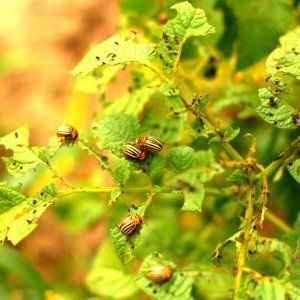 The insect feeds on pepper leaves. The pest has an oval, convex body and striped wings. Both larvae and adult beetles are dangerous.
The insect feeds on pepper leaves. The pest has an oval, convex body and striped wings. Both larvae and adult beetles are dangerous.
Pests overwinter in the soil and come to the surface in the spring. The lifespan of the Colorado potato beetle is one year, but individual individuals can live for 2-3 years.
If the beetles are in danger, they pretend to be dead. They are dangerous because they literally destroy plant bushes before our eyes, which is why they soon die.
The pest received its name in honor of the state of Colorado in the USA. An invasion of beetles in this place led to the devastation of the potato field.
At the end of the 19th century, the insect was brought to Germany, and a few decades later to France, from where the Colorado potato beetle spread throughout Europe.
Spider mites
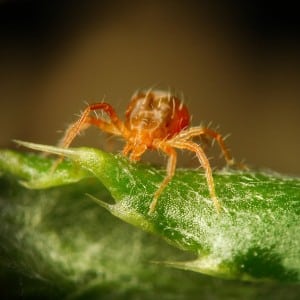 The size of the bug is no more than 0.5-1 mm. The tick camouflages itself with the color of the foliage, making it very difficult to see. It changes color from dark green to light brown. The pest attaches itself to the back of the leaf, pierces it and sucks out the juice.
The size of the bug is no more than 0.5-1 mm. The tick camouflages itself with the color of the foliage, making it very difficult to see. It changes color from dark green to light brown. The pest attaches itself to the back of the leaf, pierces it and sucks out the juice.
At the same time, the spider mite secretes a liquid that is dangerous for plants. If you do not notice the pest in time and do not take action, you can lose the entire harvest. The bushes wither, the fruits lose their firmness and elasticity.
Wireworm
The pest lives in the soil and feeds on the roots of the plant, causing the bushes to stop growing. Peppers lose their taste and become lethargic.
The wireworm looks like a thick, dark-colored worm. You can notice that wireworms have settled in the beds by looking at the holes in the ground.
May beetle larvae
Basically, pests eat up the roots of young bushes. Small white worms appear due to improper care or contaminated soil.
The larvae live in the ground for up to 3-4 years. The most harmful are those that have reached the second or third year of development. Insects disrupt metabolic processes and negatively affect the development of the bush.
Pests in a greenhouse or in open ground
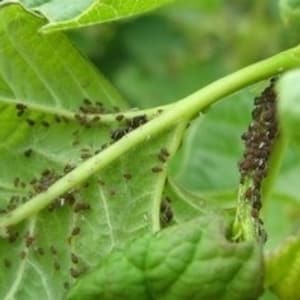 Most pests live both in the greenhouse and in open ground. However, whiteflies, Colorado potato beetles and mole crickets are most often found in structures.
Most pests live both in the greenhouse and in open ground. However, whiteflies, Colorado potato beetles and mole crickets are most often found in structures.
They appear there due to a special microclimate: high humidity and heat. The mole cricket is a powerful insect with a shell about 5-8 cm long.
The pest has a forked tail and large wings. The mole cricket eats the underground part of the pepper.
Open ground is characterized by aphids and spider mites. They arise due to frost, waterlogging of the soil or excess fertilizing. To prevent the appearance of pests, gardeners take a number of preventive and therapeutic measures.
What to process
Among the variety of means, summer residents prefer to use traditional methods, chemicals and pharmaceuticals. What are their differences from each other, and which drug is the most effective, we will understand further.
Chemicals
Chemicals are one of the most effective and fastest methods of pest control. They are sold at any gardening store. The disadvantage of such drugs is that some of them are toxic.
Description of the most popular means:
- "Bikol" - pesticide, protects most garden plants from pests. “Bikol” is especially effective in the fight against the Colorado potato beetle. The beds are treated with the product every 6-8 days.
- "Lepidocide" Recommended for protection against whiteflies and mole crickets. Spray peppers at intervals of 7 days. They are used for both prevention and treatment of plants.
- "Arrivo" designed to kill eggs, larvae and adult insects. The product is sensitive to external factors, so it is better to treat bushes in dry, windless weather. The interval between procedures is 10-15 days.
- "Nurel" fights most insect pests. The effectiveness of the drug is not affected by precipitation and other external factors. "Nurel" works even at low air temperatures and in hard-to-reach places. Peppers are processed 2-3 times per season. Works on both sweet and bitter peppers.
Important! When treating pepper with chemicals, follow the dosage and manufacturer's recommendations. Prepare a respirator, rubber gloves and safety glasses in advance.
Pharmacy products
Pharmaceutical products are much cheaper than chemicals, but they are safer and harmless to human and animal health. The following will come to help with pests:
- Iodine. For 10 liters of water you will need 10 drops of iodine. Spraying serves as an excellent prevention of pests. Carry out the procedure in the early morning or evening to avoid sunburn.
- Solution boric acid helps get rid of insects in the greenhouse. Mix 2 g of acid in 10 liters of water. The product performs well during the fruiting period. The peppers grow large and tasty.
- Tar or laundry soap - An excellent remedy for preventing the appearance of aphids and whiteflies. For 10 liters of warm water, 150 g of dry grated soap is required.
- Potassium permangantsovka indispensable both at the planting stage and at the plant care stage. With its help, seeds and soil are disinfected, and bushes are also treated against pests. Experienced gardeners recommend mixing 10 liters of warm water, 500 g of dry wood ash and 30 g of potassium permanganate. This composition not only protects against insects, but also improves the quality of the soil.
Folk remedies
Gardeners share tips for controlling insect pests. Folk remedies have been tested for generations. Gardeners use:
- dusting plants with dry wood ash;
- spraying bushes with saline solution (1 kg of table salt per 10 liters of water);
- spraying with a mustard-based solution (10 g of powder per 1 liter of water);
- treatment with infusion based on burdock leaves;
- treatment with a solution based on red hot pepper (boil 100 g of dry pods in 1 liter of water under a lid for two hours);
- spraying based on onion or garlic peels.
Processing technique
How to spray bushes? Prepare a product or preparation that will be used to spray the pepper beds. The spray bottle must be clean and dry, without any residues of old solutions. The distance between the device and the bush should be at least 40-60 cm.
It is undesirable to have small children or pets nearby. It is recommended to treat bushes on a dry and cloudy day. If the drug is toxic, then protective equipment must be used. During the procedure you should not drink or eat, or smoke.
After treatment, carefully wash garden tools and put them away until next use.
Sweet pepper diseases and their control
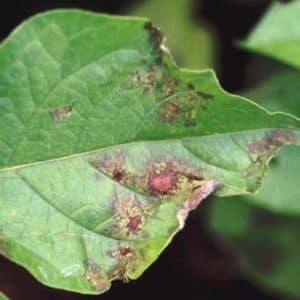 In addition to pests, peppers are susceptible to various diseases. The reasons for their appearance are the same as the reasons for the appearance of insects: improper care, contaminated soil, lack of fertilizing.
In addition to pests, peppers are susceptible to various diseases. The reasons for their appearance are the same as the reasons for the appearance of insects: improper care, contaminated soil, lack of fertilizing.
The most common diseases:
- Late blight. Appears as yellow-brown spots on leaves and fruits. Late blight is a fungus. Infection occurs through spores. Late blight often appears in greenhouses, as there is high humidity there. To combat, use ash solution or manganese. Photos of leaves affected by late blight are presented below.
- Powdery mildew is a virus. Looks like a white coating on the leaves. Dew appears due to an excess of nitrogen-containing fertilizers or non-compliance with crop rotation rules. An excellent way to combat powdery mildew is whey-based sprays.
- Black bacterial spot appears as small black spots on the fruit and stem.Soap sprays are used as a preventive measure. It is better to remove infected bushes from the garden and burn them.
Advice from experienced farmers
In order not to see unwanted insects in their beds, experienced farmers recommend following the following recommendations:
- Before planting, thoroughly disinfect the seeds and beds. Dig up the soil in advance and add organic and mineral fertilizers to the soil.
- Plant peppers in a bright, windless area.
- The best predecessors for peppers are onions, herbs, and legumes. It is better not to plant vegetables after potatoes and zucchini.
- Water the plants once every 5-7 days. Use settled water for irrigation.
- As a preventative measure, spray the bushes once every 2 weeks with whey or soap solution.
- Regularly inspect the beds for diseases or pests.
- At the first signs of damage, begin treatment immediately.
Conclusion
Insect pests can be eliminated using folk remedies and professional preparations. Budget-friendly and effective means are ash, manganese, laundry soap. Solutions based on these ingredients are safe for human health and do not harm vegetables.
Professional products, for example, Bicol or Arrivo, are sold in specialized stores for gardeners. Before using them, be sure to carefully read the instructions and recommendations for use. Which product to choose is up to you. The main thing is to start the fight as early as possible and not forget about prevention.
Error: the size of the tick is indicated in cm, but this is the size in mm!!!
For the rest, it’s worth listening to advice.
Thanks, corrected)